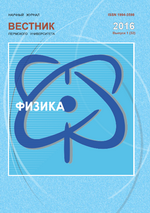Stability of homogeneous non-stationary surfactant diffusion through a flat interface between liquids
DOI:
https://doi.org/10.17072/1994-3598-2016-1-64-70Abstract
A non-stationary transfer of a surfactant across the interface between two liquids, in both of which the surfactant is soluble, is considered in the two-dimensional formulation. It is assumed that at the interface, two liquids form a surface phase, and the transfer of the substance is carried out by the adsorption and desorption processes. At the initial time all surface-active substance is distributed in a “droplet”, located at one end of a rectangular channel. The finite difference method is employed to investigate unsteady diffusion in microgravity conditions. The general equations of material balance at the boundary of surface phase and bulk phase were simplified in approximation of diffusion kinetics. In the “droplet” near the surface phase, linear variation of the concentration of surfactant is assumed on the three grid points in the direction normal to the boundary. In the channel, an equilibrium between the adsorption and desorption processes is assumed, and the bulk concentration at the boundary is determined by the value of the surface concentration. It was found that for sufficiently large values of the Marangoni number, convection occurs at some point in time. For several values of the Marangoni number, the maximum value of stream function is shown as a function of time. Several maxima of the convection intensity were observed. The structure of the convective motion was changing with time. The dependence of the convective motion on the ratio of absorption coefficients of the fluids in the “droplet” and the channel was investigated. If the adsorption coefficient in the “droplet” is higher than in the channel, the motion occurs in the form of four vortex structures in each region, which is over time restructuring into a one-vortex flow. If relationship of these coefficients is inverse, the four-vortex flow is reconstructed into two vortexes in each area. Besides, a calculation of the diffusion process in a system, where the surfactant transfer through the liquid interface occurs without forming the surface phase. In this case, Marangoni convection occurs at shorter times and with considerably greater intensity. The initial small-scale four-vortex motion, transfers through the two-vortex stage into one large-scale vortex motion.Received 18.04.2016; accepted 29.04.2016References
Sternling C. V., Scriven L. E. Interfacial turbulence: hydrodynamic instability and Marangoni effect. AIChE Journal, 1959, vol. 5, no. 4, pp. 514–523.
Hennenberg M., Bisch P. M., Vignes-Adler M., Sanfeld A. Mass transfer, Marangoni effect, and instability of interfacial longitudinal waves. I. Diffusional exchanges. Journal of Colloid and Interface Science, 1979, vol. 69, pp. 128–137.
Hennenberg M., Bisch P. M.,Vignes-Adler M., Sanfeld A. Mass transfer, Marangoni effect, and instability of interfacial longitudinal waves. II. Diffusional exchanges and adsorption-desorption processes. Journal of Colloid and Interface Science. 1980, vol. 74, pp. 495–508.
Slavtchev S., Hennenberg M., Legros J.-C., Lebon G. Stationary solutal Marangoni instability in a two-layer system. Journal of Colloid and Interface Science, 1998, vol. 203, pp. 354–368.
Rednikov A. Y., Ryazantsev Y. S., Velarde M. G. Drop motion with surfactant in a homogeneous surrounding. Physics of Fluids, 1994, vol. 6, pp. 451–468.
Birikh R. V., Briskman V. A., Velarde M. G., Legros J.-C. Liquid Interfacial Systems:Oscillations and Instability. Surfactant science series, vol. 113. New York: Basel, 2003. 367 p.
Gershuni G. Z., Zhukhovitskii E. M. Convective stability of incompressible fluids. Jerusalem, Israel: Keter Publishing House, 1976, 330 p.
Downloads
Published
How to Cite
Issue
Section
License
Автор предоставляет Издателю журнала (Пермский государственный национальный исследовательский университет) право на использование его статьи в составе журнала, а также на включение текста аннотации, полного текста статьи и информации об авторах в систему «Российский индекс научного цитирования» (РИНЦ).
Автор даёт своё согласие на обработку персональных данных.
Право использования журнала в целом в соответствии с п. 7 ст. 1260 ГК РФ принадлежит Издателю журнала и действует бессрочно на территории Российской Федерации и за её пределами.
Авторское вознаграждение за предоставление автором Издателю указанных выше прав не выплачивается.
Автор включённой в журнал статьи сохраняет исключительное право на неё независимо от права Издателя на использование журнала в целом.
Направление автором статьи в журнал означает его согласие на использование статьи Издателем на указанных выше условиях, на включение статьи в систему РИНЦ, и свидетельствует, что он осведомлён об условиях её использования. В качестве такого согласия рассматривается также направляемая в редакцию справка об авторе, в том числе по электронной почте.
Редакция размещает полный текст статьи на сайте Пермского государственного национального исследовательского университета: http://www.psu.ru и в системе OJS на сайте http://press.psu.ru
Плата за публикацию рукописей не взимается. Гонорар за публикации не выплачивается. Авторский экземпляр высылается автору по указанному им адресу.

